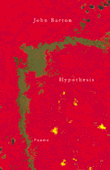
|
Hypothesis
by John Barton
House of Anansi Press, 2001
Reviewed by Shane Neilson
(Read
an interview with John Barton by Shane Neilson.)
Hypothesis is willfully uncommon book, juggling two complex subjects at once: homosexuality and sexual writing are both used as a portal to a greater consideration of humanity. Making things even more daring is Barton’s methodological embrace of the evidenced-based tradition of basic science, not the freestyle kitchen sinkism of modern verse, with its attendant formlessness. All of his poems are crafted according to the basic modus operandi of science: they have a central hypothesis (hence the collection’s title) followed by a series of observations that make up the body of the poem, and a conclusion coming at poem’s end that often restates the earlier hypothesis from the perspective of acknowledging the many made observations. In other words, Barton proves poetic hypotheses in his poems. Has science ever been so organically incorporated within art?
Barton's science isn't the didactic pedantry of textbook; instead, it is an active process. He writes poems that are experimental; he also writes poems that are experiments, and in so doing involves the reader in their conduction. Consider "Watershed", the first poem in the book, which typically begins with a poetic hypothesis: "Everywhere the blue and green world." What then follows are a series of images that prove this hypothesis, including "...The disparate shores of the park...", "...a blue heron lifts greyly from the bird sanctuary,/ mallards with matte malachite/ heads...", and "...this bed a raft of green, fresh-cut/ logs shot/ forward by the snow/ melt of my for-now exhausted blues...". After more of this beautiful proof, the initial hypothesis solidifies into a law in the poem's circular, concluding line: "Everywhere the blue and green world."
"Watershed" is a formal poem that relies upon the structure of scientific enquiry; "Phone Lines" also has a hypothesis to prove, but it is more vehemently experimental in form. Barton uses
E.M. Forster's advice of "Only connect" and a paradoxical series of oppositions to write nimble lines of logical progression:
"Voicelessness-
and then, circumspectly,
there are too many
inside the head and out, sound
bytes spliced into this a capella
choir..."
Voicelessness is opposed by "too many" voices. Voices make "sound", which is unaccompanied ("a
capella") and accompanied ("choir.") The poem continues:
...each one of us
a soloist who just
had to call in,
desires inharmonic
and randomly
arranged
ad hominem...
Here the personal lone voice is invoked again by the word "soloist", which is linked back to the poem's title of "Phone Lines" by the "one" who "had to call in." Ad hominem is defined in the Canadian Oxford Dictionary as "relating to or associated with a particular person.", reiterating the theme of the personal. There are a further two-and-a-half more pages of this dense connectivity building to the poem's unpredictable, simultaneously connective (the metaphor of the title again, the word "connecting", the return to "voices") and disconnective (the word "disconnect", the "voices... erased") ending:
...phone
lines
connecting to
only disconnect-
all voices safely erased.
Barton tempers the intellectual with the carnal. His lovemaking poetry espouses an enthusiastic eroticism that could only be considered academic if the bonking happened in a University bathroom. The carnality is straightforward, hopeful, and tainted with decay. A HIV-infected man reflects in the title poem: "[he] took chances/ in bed he recognized/ too late, the trust between lovers/ a probability except/ by intuition." It is also sock-knocking, window-steaming stuff, as in
"Pret-a-Porter": "... The dead layer of skin you wash from his back/ whenever he is/ lonely and nakedly in need/ of the tenderness you give/ without question, cock/hardening against his spine...you ask him to/ caress your body/ to clothe it/ with pleasures only the weave/ of his tongue can tease out, lingering over your nipples...".
The elegiac heart of this book (as opposed to the cool head and hot loins) is the AIDS pandemic; poems are written to edify the illness, and the result is quite moving. Men are depicted in various stages of disease, all of which are signposts to eventual death. The most common theme is that of a man trying to make sense of the carnage; the usual vehicle is a poem consisting of two people in a relationship, HIV between them, Barton involving the reader by using the first person: "... given to heal something/ between us in ways the year that tore us apart never could... While all around us men were dying, men we did/ not know and read about in the paper, men like us, bodies full of a virus..."
As is obvious, this poetry is unapologetically intellectual. I won't apologize for it, either- verifiable science is reproducible. Pick up specimen Barton and evaluate the evidence for yourself. Possessing brains, stylistic brawn, and a musky man-sex, his
Hypothesis conveys science as art. Sex stays sexual. The sheer vigour tempered by scientific rigour is something to behold. Test this book. It will test you too.
Shane Neilson is a poetry editor with
The Danforth Review.
|